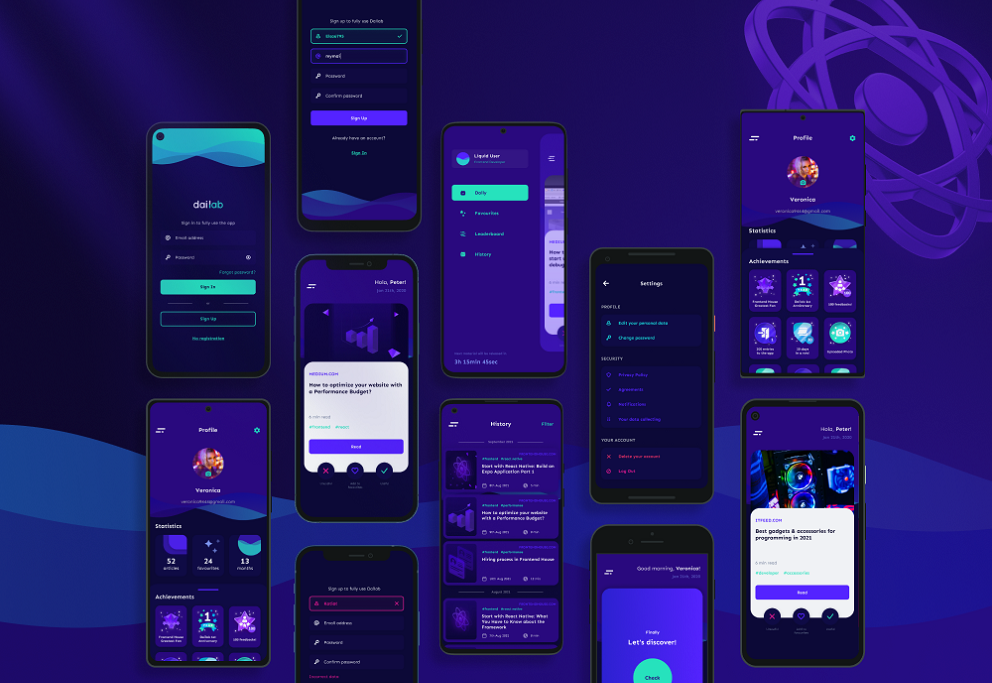Technologie
Building mobile apps with React Native


Ready to capitalize on the growing mobile market?
Most data shows that mobile applications have generated more and more global revenues, which is a great opportunity for businesses. However, users have already seen hundreds of apps on their smartphones and new apps come every day. How to find a better and more unique way to create a digital product that will be able to stand in the market? The answer is React Native, which enables us to amaze users with applications that are impressive, work seamlessly, and integrate with their mobile OS.
What is React Native?
React Native is a framework that allows developers to build native mobile applications using JavaScript. It was developed by Facebook to solve the problem of maintaining two codebases: one for iOS and one for Android. It helps build fully functional applications on both platforms in much less time and using just one coding language.

React Native is a natural consequence of React, which was created in 2011. Both frameworks are closely related to each other, but they serve different purposes: React is used for web development and React Native is used for mobile development. Today, around 15% of all installed apps are built with React Native. In the category of top US applications, React Native is the third most popular framework, after Kotlin and Android Architecture Components.
Why choose React Native development services?
01
Trusted and reliable
02
One codebase for two platforms
03
Performance
04
Code reusability
05
Cost-efficiency
06
Flexibility
07
Hot reloading feature
React Native has been gaining popularity and this is why:
It’s trusted and reliable. Many companies have decided to bet on it and create their mobile apps this way.
One codebase for two platforms. React Native allows you to create one codebase that works on both Android and iOS. The framework builds a bridge between web UI components and their native Java/Swift counterparts, so you don’t need two development teams for two platforms. You don’t have to choose which version to build and launch first.
Performance. React Native’s functional part allows amazing performance and more seamless work of applications. The framework allows the usage of natively written code (native code so it’s not as laggy as web-based cross-platform solutions. Also, as React Native takes advantage of the graphics processing unit instead of mainly using the central processing unit, React Native apps are much faster than cross-platform hybrid technologies.
Code reusability. Utilizing the same codebase for different platforms carries one more benefit – the development process is much faster which makes the time-to-market of your app faster, too.
Cost-efficiency. You need a smaller team to deliver your project as you can reuse code on multiple platforms.
Flexibility. React Native uses the type of interface that is easy for different developers to jump in where someone else left off and continue building. This makes the framework incredibly flexible and easy to upgrade and update.
Hot reloading feature. The function enables developers to immediately view the changes they have made to the code in another live preview window simultaneously.
When should you bet on using React Native?
There are literally no real industry-related constraints on when you can or cannot use React Native. The framework is perfect for all customer-facing apps that don’t rely heavily on OS-specific features and integrations or don’t need complex design or animations to establish a competitive advantage. React Native is actively used by real giants that offer:
- Social media platforms (Facebook, Instagram)
- eCommerce (Walmart – 95% of the code used in their app is written in React Native; Shopify – React Native helps them enhance the app experience across iOS and Android platforms)
- Content and media (Bloomberg)
As you can see, React Native is highly versatile. It offers top-notch performance and at the same time, it is cost-effective – it is much cheaper and easier to build one app than two separate native apps with the same service or product. For us, React Native is a great and reliable solution for the endeavor and we’ll be happy to make the most out of it in your app.

React Native app development process at Liki
Our React Native development process is simple, yet comprehensive. When you start collaborating with us, we will follow these steps together:
1. Product discovery and planning – we organize a workshop to get familiar with your business needs. We conduct a thorough market analysis and research on your competitors. We also break down the work into manageable milestones.
2. Writing backlog and creating architecture. After this phase, we have the initial structure of your React Native application. To keep the workflow highly efficient, we also prepare the CI/CD configuration.
3. Building a UI pattern library. This ensures consistency across all the components of the future web app.
4. Developing features.
5. End-to-end testing. This phase ensures that the required business functions operate well and fit the real-world environment.
6. Launch and maintenance.
Looking for React Native developers?
If you want to develop a cross-platform, cross-browser app, React Native should be your first choice. We’ve been working with the framework for ages, and we know how to make the most out of it. Let’s develop your React Native project together!

Kasia
Digital Value Manager

Damian
Business Representative

Piotr
Business Representative

Adrian
Head of Frontend
